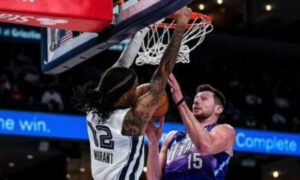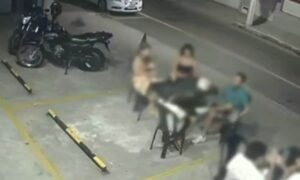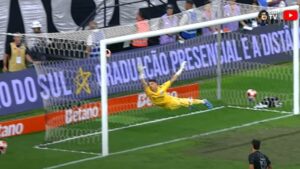Former UFC heavyweight champion Cain Velasquez received a five-year prison sentence on Monday, March 24, following a highly publicized trial that gripped the mixed martial arts community. The verdict came from the Santa Clara County Superior Court in San Jose, California, where Velasquez faced charges of attempted murder and related offenses stemming from a February 2022 shooting. The ex-fighter, who did not contest the accusations, pursued and fired at a vehicle carrying Harry Goularte, a man accused of sexually abusing Velasquez’s four-year-old son at a daycare, in a dramatic high-speed chase.
Although sentenced to five years, Velasquez’s time behind bars could be shorter. Judge Arthur Bocanegra factored in the 1,283 days he already spent in custody or under house arrest during the legal process, meaning he might serve roughly two more years, potentially until mid-2026, with good behavior possibly reducing that further. The ruling sparked widespread reactions, from outrage among supporters to debates about justice and vigilantism, amplifying the case’s resonance beyond the courtroom.
Velasquez, once a dominant force in the UFC, saw his life unravel after retiring from fighting in 2019. The incident thrust him from the octagon into a legal battle that captivated fans and fighters alike. While his athletic legacy remains celebrated, this chapter has cast a shadow over his post-career path, raising questions about retribution and the limits of parental protection.
Rise of a heavyweight legend
Cain Velasquez carved out a storied career in the UFC before the events that led to his imprisonment. Born in 1982 in Salinas, California, he rose to prominence as one of the most formidable heavyweights in MMA history, securing the UFC title twice. His first championship win came in 2010, when he demolished Brock Lesnar with a first-round knockout, showcasing his blend of power and precision. After losing the belt to Brazil’s Júnior dos Santos in 2011, he reclaimed it in 2012, dominating dos Santos in a rematch that solidified his reputation.
Injuries plagued Velasquez throughout his career, limiting his time in the spotlight. His final UFC fight occurred in 2019, a swift 26-second knockout loss to Francis Ngannou, ending a record of 14 wins and 3 losses. Post-retirement, he ventured into professional wrestling with WWE, but his focus shifted dramatically when allegations surfaced about his son’s abuse, setting the stage for the fateful 2022 confrontation.
Beyond the cage, Velasquez was known for his quiet demeanor and dedication. His achievements inspired a generation of fighters, yet the personal tragedy that followed redefined his public image, intertwining his legacy with a narrative of vengeance and consequence.
The day everything changed
On a February day in 2022, Cain Velasquez’s life took a drastic turn. After learning that Harry Goularte, a man tied to a daycare his son attended, allegedly molested the four-year-old, Velasquez acted on his own. He tracked down Goularte, who was in a vehicle with his stepfather, Paul Bender, and initiated an 11-mile chase through California streets. Armed with a .40-caliber handgun, Velasquez fired multiple shots at the car, missing Goularte but striking Bender in the arm and torso.
The pursuit unfolded near a school in San Jose, heightening the danger as children exited the premises. Police arrested Velasquez shortly after, and he spent eight months in custody before posting a $1 million bail—nearly $5 million in Brazilian reais at the time—allowing him to await trial under house arrest. The incident’s proximity to innocent bystanders and the injury to Bender complicated the legal fallout, amplifying the charges against him.
Goularte, meanwhile, faces his own legal battle over the abuse allegations, pleading not guilty with a trial set for June this year. The Velasquez family has also filed a civil lawsuit against Goularte and his relatives, who ran the daycare, seeking damages for the trauma inflicted on their son, adding another layer to this multifaceted saga.
Fighters rally behind Velasquez
The sentencing of Cain Velasquez ignited a firestorm of support within the MMA world. Prominent fighters, including Jorge Masvidal, Luke Rockhold, and Gilbert Melendez, voiced solidarity, framing his actions as a father’s desperate response to unimaginable pain. Social media buzzed with messages defending Velasquez, with many arguing he deserved leniency rather than punishment, given the emotional stakes.
Fans echoed this sentiment, launching hashtags like “Free Cain” and calling for intervention from figures like California Governor Gavin Newsom or even former President Donald Trump. The outpouring revealed a divide: while some condemned the recklessness of the shooting, others saw Velasquez as a victim of a flawed justice system unable to protect his child.
- Jorge Masvidal: Slammed California’s legal system, calling Velasquez’s sentence unfair for a protective father.
- Luke Rockhold: Insisted most men would react similarly under such duress.
- Oban Elliott: Floated the idea of a presidential pardon to free the ex-champ.
Key moments in the Velasquez case
The legal journey of Cain Velasquez unfolded over several pivotal stages:
- February 2022: Velasquez chases and shoots at Goularte’s vehicle, leading to his arrest.
- November 2022: Released on $1 million bail after eight months in jail.
- August 2024: Enters a “no contest” plea to attempted murder and related charges.
- March 24, 2025: Sentenced to five years, with credit for time served.
- Projected release: Expected around early 2027, possibly sooner with good conduct.
This timeline captures a saga that began with a single act of rage and evolved into a prolonged legal ordeal, leaving Velasquez’s future uncertain.
Inside the courtroom
During the trial at Santa Clara County Superior Court, Judge Arthur Bocanegra weighed arguments from both sides. Prosecutors pushed for a harsh penalty—up to 30 years or life—citing the public danger posed by Velasquez’s actions in a busy area. The defense, led by attorney Renee Hessling, sought probation, emphasizing his clean record and the emotional trigger behind the incident.
Velasquez took accountability, a stance he reiterated in a recent podcast with Kyle Kingsbury. “I know what I did was wrong, and I’m ready to face the consequences,” he said, acknowledging the peril his choices posed to others. His decision not to fight the charges shaped the sentencing, which landed at five years—a compromise between the prosecution’s demands and the defense’s plea.
Hessling called the outcome “bittersweet,” mourning the prison term but praising Velasquez’s resilience. The ruling reflected both the severity of the crime and the mitigating factor of a father’s anguish, a balance that left neither side fully satisfied.
Roots of the rage
The catalyst for Velasquez’s actions was the alleged abuse of his son at a daycare linked to Harry Goularte’s family. Reports suggest the child endured over 100 instances of molestation, a revelation that shattered the Velasquez household. Goularte, charged with child abuse, denies the claims and awaits his day in court, while the family pursues a civil case against him and his mother, who operated the facility.
That civil suit, with a hearing slated for November, seeks accountability for the alleged failures at the daycare. The slow pace of justice in Goularte’s criminal case likely fueled Velasquez’s frustration, pushing him to take matters into his own hands—a decision that cost him his freedom and injured an unintended target, Paul Bender.
Bender, hit during the shooting, became a collateral casualty. His testimony and his family’s statements underscored the chaos of that day, bolstering the prosecution’s case by highlighting the broader impact of Velasquez’s pursuit.
Legacy under scrutiny
Cain Velasquez’s mark on MMA endures despite his legal troubles. Hailed as a heavyweight titan, he mentored stars like Daniel Cormier and Khabib Nurmagomedov at the American Kickboxing Academy, shaping the sport’s elite. His technical prowess and relentless style earned him a lasting place in UFC lore, even as this chapter challenges how he’s remembered.
Before his sentencing, Velasquez stayed involved in combat sports, coaching at events with court approval and joining the Global Fight League as a team manager alongside coach Javier Mendez. Those plans are now on hold, but his influence persists, a testament to a career that transcended wins and losses.
The duality of his story—champion turned convict—adds complexity to his narrative. For many, he remains a hero who faltered under unbearable strain, while others see a cautionary tale of justice gone awry.
Voices from the MMA world
Support for Velasquez extended beyond individual comments, with fighters and fans mobilizing online. The “Free Cain” movement gained traction, reflecting a belief that his punishment overlooked the provocation he faced. This groundswell underscored his enduring popularity and the empathy his plight evoked.
Critics, however, stressed the need for legal boundaries. The injury to Paul Bender and the near-miss at a school fueled arguments that Velasquez’s actions, however justified emotionally, endangered lives. This tension between personal and public justice continues to define reactions to his case.
- Case highlights:
- Velasquez used a legally owned firearm in the attack.
- The shooting occurred steps from a San Jose school.
- His $1 million bail ranks among the highest in MMA history.
Life after the verdict
At 42, Cain Velasquez now confronts a future shaped by his sentence. With good behavior, he could walk free by 2026, resuming roles like his Global Fight League position. Until then, his focus will likely remain on enduring incarceration while his family navigates the ongoing legal fight against Goularte.
The outcome of Goularte’s trial and the civil suit could bring closure or further turmoil for the Velasquez family. Whatever lies ahead, Cain’s journey—from UFC glory to prison bars—remains a compelling saga of triumph, tragedy, and the high cost of retribution.

Former UFC heavyweight champion Cain Velasquez received a five-year prison sentence on Monday, March 24, following a highly publicized trial that gripped the mixed martial arts community. The verdict came from the Santa Clara County Superior Court in San Jose, California, where Velasquez faced charges of attempted murder and related offenses stemming from a February 2022 shooting. The ex-fighter, who did not contest the accusations, pursued and fired at a vehicle carrying Harry Goularte, a man accused of sexually abusing Velasquez’s four-year-old son at a daycare, in a dramatic high-speed chase.
Although sentenced to five years, Velasquez’s time behind bars could be shorter. Judge Arthur Bocanegra factored in the 1,283 days he already spent in custody or under house arrest during the legal process, meaning he might serve roughly two more years, potentially until mid-2026, with good behavior possibly reducing that further. The ruling sparked widespread reactions, from outrage among supporters to debates about justice and vigilantism, amplifying the case’s resonance beyond the courtroom.
Velasquez, once a dominant force in the UFC, saw his life unravel after retiring from fighting in 2019. The incident thrust him from the octagon into a legal battle that captivated fans and fighters alike. While his athletic legacy remains celebrated, this chapter has cast a shadow over his post-career path, raising questions about retribution and the limits of parental protection.
Rise of a heavyweight legend
Cain Velasquez carved out a storied career in the UFC before the events that led to his imprisonment. Born in 1982 in Salinas, California, he rose to prominence as one of the most formidable heavyweights in MMA history, securing the UFC title twice. His first championship win came in 2010, when he demolished Brock Lesnar with a first-round knockout, showcasing his blend of power and precision. After losing the belt to Brazil’s Júnior dos Santos in 2011, he reclaimed it in 2012, dominating dos Santos in a rematch that solidified his reputation.
Injuries plagued Velasquez throughout his career, limiting his time in the spotlight. His final UFC fight occurred in 2019, a swift 26-second knockout loss to Francis Ngannou, ending a record of 14 wins and 3 losses. Post-retirement, he ventured into professional wrestling with WWE, but his focus shifted dramatically when allegations surfaced about his son’s abuse, setting the stage for the fateful 2022 confrontation.
Beyond the cage, Velasquez was known for his quiet demeanor and dedication. His achievements inspired a generation of fighters, yet the personal tragedy that followed redefined his public image, intertwining his legacy with a narrative of vengeance and consequence.
The day everything changed
On a February day in 2022, Cain Velasquez’s life took a drastic turn. After learning that Harry Goularte, a man tied to a daycare his son attended, allegedly molested the four-year-old, Velasquez acted on his own. He tracked down Goularte, who was in a vehicle with his stepfather, Paul Bender, and initiated an 11-mile chase through California streets. Armed with a .40-caliber handgun, Velasquez fired multiple shots at the car, missing Goularte but striking Bender in the arm and torso.
The pursuit unfolded near a school in San Jose, heightening the danger as children exited the premises. Police arrested Velasquez shortly after, and he spent eight months in custody before posting a $1 million bail—nearly $5 million in Brazilian reais at the time—allowing him to await trial under house arrest. The incident’s proximity to innocent bystanders and the injury to Bender complicated the legal fallout, amplifying the charges against him.
Goularte, meanwhile, faces his own legal battle over the abuse allegations, pleading not guilty with a trial set for June this year. The Velasquez family has also filed a civil lawsuit against Goularte and his relatives, who ran the daycare, seeking damages for the trauma inflicted on their son, adding another layer to this multifaceted saga.
Fighters rally behind Velasquez
The sentencing of Cain Velasquez ignited a firestorm of support within the MMA world. Prominent fighters, including Jorge Masvidal, Luke Rockhold, and Gilbert Melendez, voiced solidarity, framing his actions as a father’s desperate response to unimaginable pain. Social media buzzed with messages defending Velasquez, with many arguing he deserved leniency rather than punishment, given the emotional stakes.
Fans echoed this sentiment, launching hashtags like “Free Cain” and calling for intervention from figures like California Governor Gavin Newsom or even former President Donald Trump. The outpouring revealed a divide: while some condemned the recklessness of the shooting, others saw Velasquez as a victim of a flawed justice system unable to protect his child.
- Jorge Masvidal: Slammed California’s legal system, calling Velasquez’s sentence unfair for a protective father.
- Luke Rockhold: Insisted most men would react similarly under such duress.
- Oban Elliott: Floated the idea of a presidential pardon to free the ex-champ.
Key moments in the Velasquez case
The legal journey of Cain Velasquez unfolded over several pivotal stages:
- February 2022: Velasquez chases and shoots at Goularte’s vehicle, leading to his arrest.
- November 2022: Released on $1 million bail after eight months in jail.
- August 2024: Enters a “no contest” plea to attempted murder and related charges.
- March 24, 2025: Sentenced to five years, with credit for time served.
- Projected release: Expected around early 2027, possibly sooner with good conduct.
This timeline captures a saga that began with a single act of rage and evolved into a prolonged legal ordeal, leaving Velasquez’s future uncertain.
Inside the courtroom
During the trial at Santa Clara County Superior Court, Judge Arthur Bocanegra weighed arguments from both sides. Prosecutors pushed for a harsh penalty—up to 30 years or life—citing the public danger posed by Velasquez’s actions in a busy area. The defense, led by attorney Renee Hessling, sought probation, emphasizing his clean record and the emotional trigger behind the incident.
Velasquez took accountability, a stance he reiterated in a recent podcast with Kyle Kingsbury. “I know what I did was wrong, and I’m ready to face the consequences,” he said, acknowledging the peril his choices posed to others. His decision not to fight the charges shaped the sentencing, which landed at five years—a compromise between the prosecution’s demands and the defense’s plea.
Hessling called the outcome “bittersweet,” mourning the prison term but praising Velasquez’s resilience. The ruling reflected both the severity of the crime and the mitigating factor of a father’s anguish, a balance that left neither side fully satisfied.
Roots of the rage
The catalyst for Velasquez’s actions was the alleged abuse of his son at a daycare linked to Harry Goularte’s family. Reports suggest the child endured over 100 instances of molestation, a revelation that shattered the Velasquez household. Goularte, charged with child abuse, denies the claims and awaits his day in court, while the family pursues a civil case against him and his mother, who operated the facility.
That civil suit, with a hearing slated for November, seeks accountability for the alleged failures at the daycare. The slow pace of justice in Goularte’s criminal case likely fueled Velasquez’s frustration, pushing him to take matters into his own hands—a decision that cost him his freedom and injured an unintended target, Paul Bender.
Bender, hit during the shooting, became a collateral casualty. His testimony and his family’s statements underscored the chaos of that day, bolstering the prosecution’s case by highlighting the broader impact of Velasquez’s pursuit.
Legacy under scrutiny
Cain Velasquez’s mark on MMA endures despite his legal troubles. Hailed as a heavyweight titan, he mentored stars like Daniel Cormier and Khabib Nurmagomedov at the American Kickboxing Academy, shaping the sport’s elite. His technical prowess and relentless style earned him a lasting place in UFC lore, even as this chapter challenges how he’s remembered.
Before his sentencing, Velasquez stayed involved in combat sports, coaching at events with court approval and joining the Global Fight League as a team manager alongside coach Javier Mendez. Those plans are now on hold, but his influence persists, a testament to a career that transcended wins and losses.
The duality of his story—champion turned convict—adds complexity to his narrative. For many, he remains a hero who faltered under unbearable strain, while others see a cautionary tale of justice gone awry.
Voices from the MMA world
Support for Velasquez extended beyond individual comments, with fighters and fans mobilizing online. The “Free Cain” movement gained traction, reflecting a belief that his punishment overlooked the provocation he faced. This groundswell underscored his enduring popularity and the empathy his plight evoked.
Critics, however, stressed the need for legal boundaries. The injury to Paul Bender and the near-miss at a school fueled arguments that Velasquez’s actions, however justified emotionally, endangered lives. This tension between personal and public justice continues to define reactions to his case.
- Case highlights:
- Velasquez used a legally owned firearm in the attack.
- The shooting occurred steps from a San Jose school.
- His $1 million bail ranks among the highest in MMA history.
Life after the verdict
At 42, Cain Velasquez now confronts a future shaped by his sentence. With good behavior, he could walk free by 2026, resuming roles like his Global Fight League position. Until then, his focus will likely remain on enduring incarceration while his family navigates the ongoing legal fight against Goularte.
The outcome of Goularte’s trial and the civil suit could bring closure or further turmoil for the Velasquez family. Whatever lies ahead, Cain’s journey—from UFC glory to prison bars—remains a compelling saga of triumph, tragedy, and the high cost of retribution.







